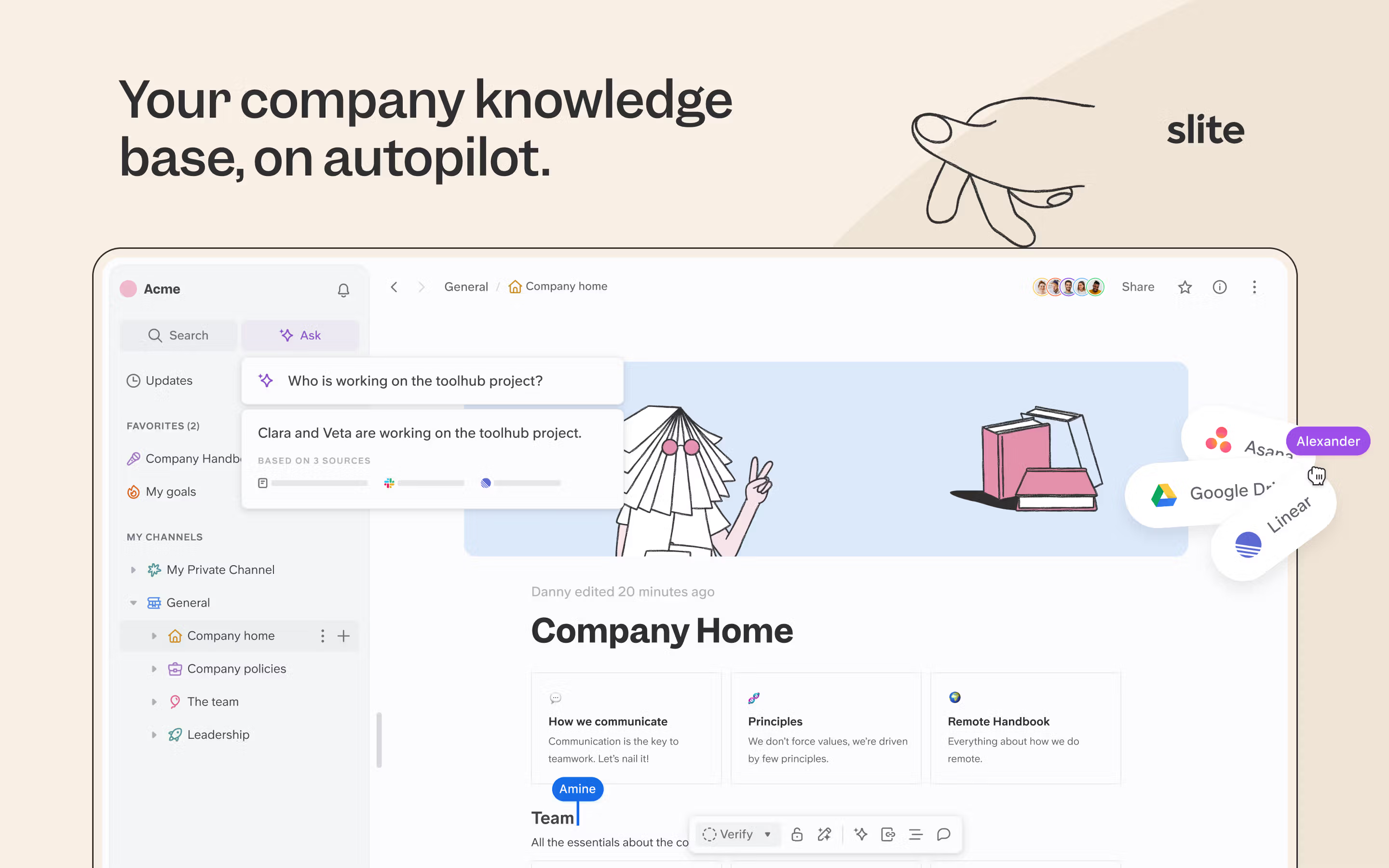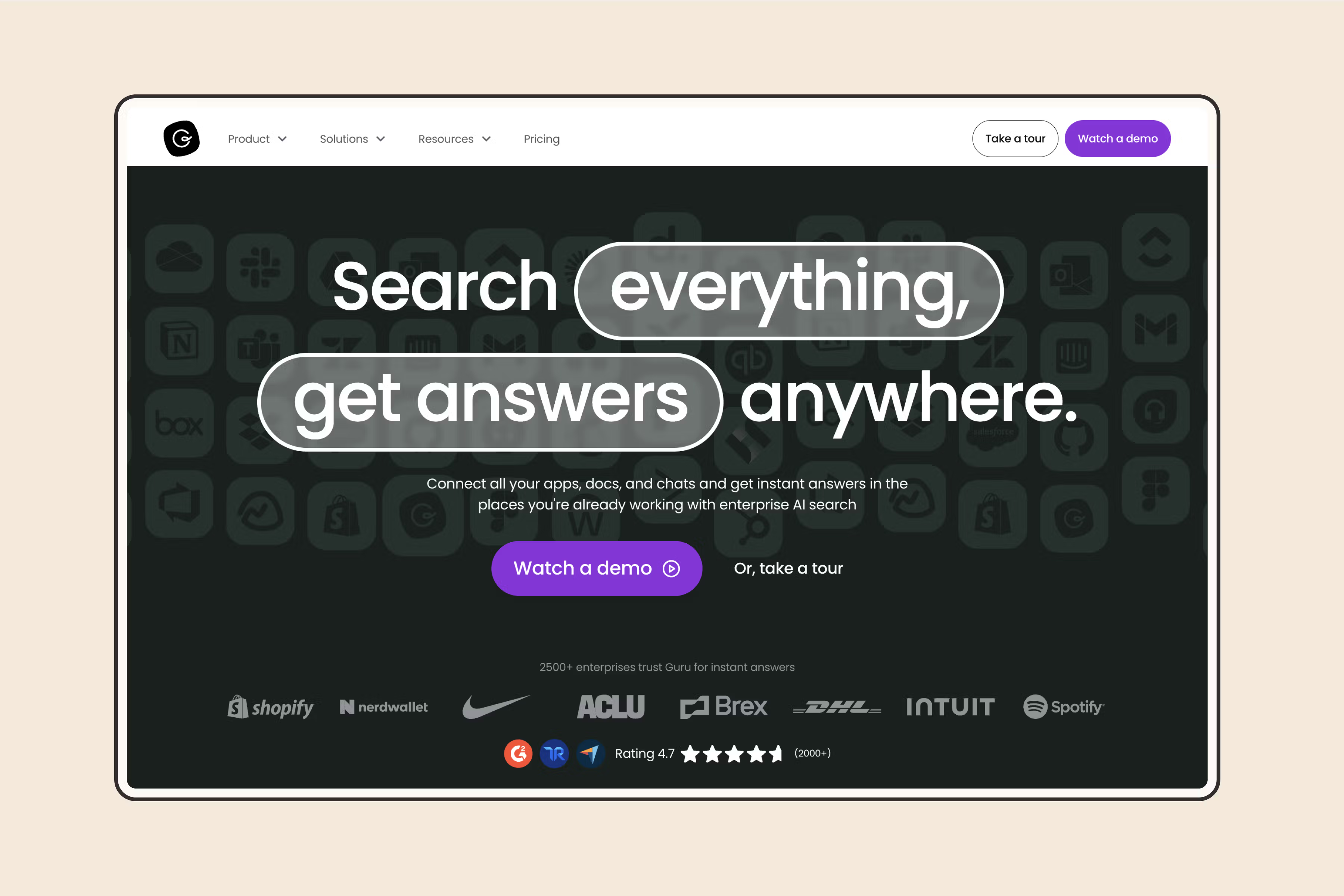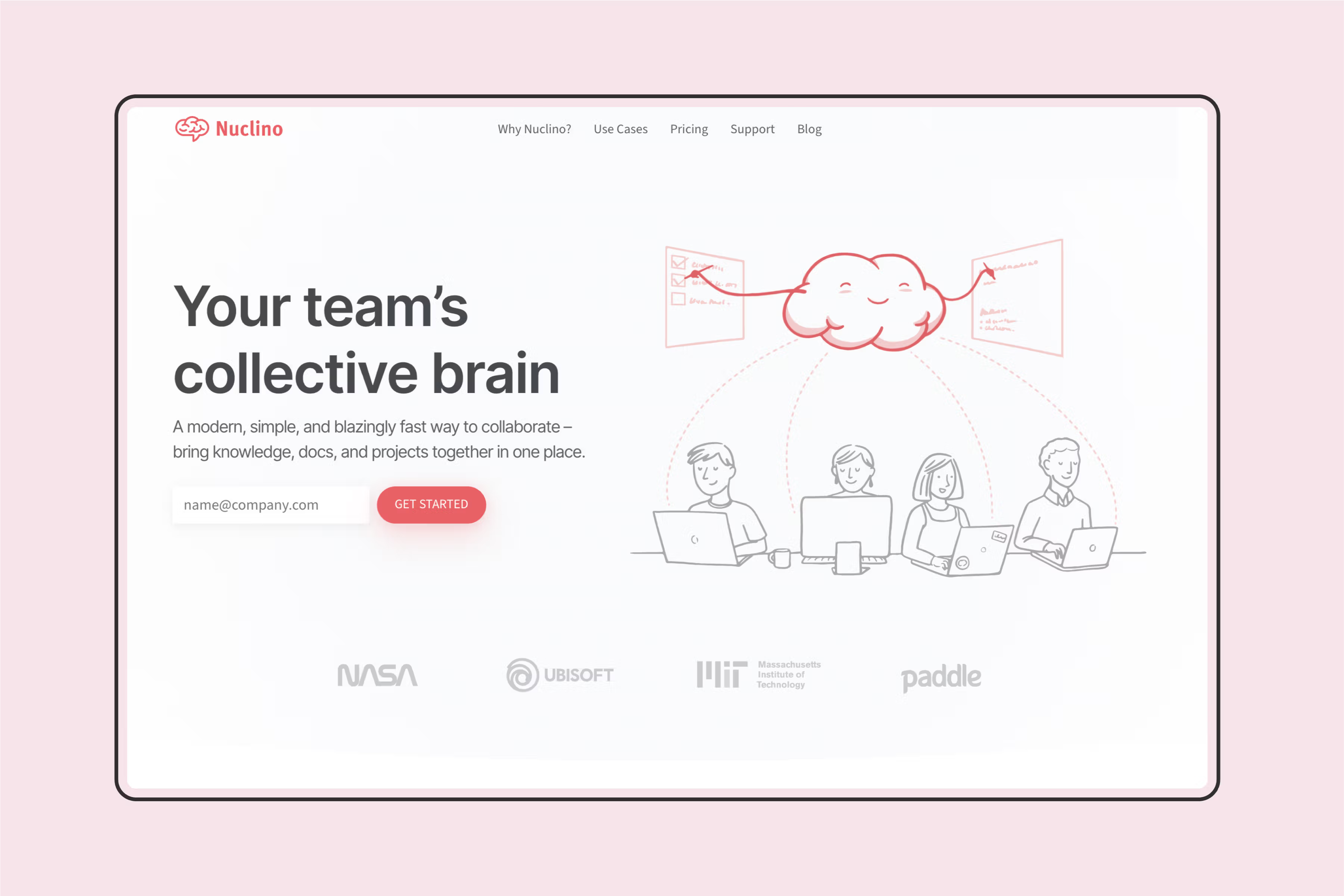Keeping everyone on the same page can feel like herding cats.
Ideas get lost in Slack threads, critical information gets buried in endless email chains, and new hires struggle to ramp up quickly.
Sound familiar? You're not alone.
That's why knowledge sharing tools have become essential.
In this guide, we'll dive deep into the world of knowledge sharing. We'll explore what it means, why it matters (hint: it's not just about avoiding those awkward "I didn't get the memo" moments), and how to create a knowledge-sharing culture that supercharges your team's productivity.
Plus, we'll unveil our top 5 picks for the best knowledge sharing tools in 2024, so let's go!
What are Knowledge Sharing Tools?
Knowledge sharing means sharing information, skills, and expertise with other team members in your team, at scale. Pretty straightforward, right?
But here’s where it gets interesting. Knowledge sharing isn’t just a one-and-done deal. It’s part of The Knowledge Loop.

This loop starts with capturing knowledge (like jotting down meeting notes or writing a how-to guide), then organizing it so it’s easy to find (think folders, tags, or even a fancy AI-powered search).
Next comes the surfacing and sharing part, where you spread that knowledge (you know, through your knowledge sharing tool). But it doesn’t stop there.
Once that knowledge is out in the wild, it gets used, questioned, and even improved upon. This feedback gets incorporated back into the knowledge base, starting the loop all over again.
By closing the knowledge loop, you’re not just sharing information, you’re creating a culture of continuous learning and improvement. You’re empowering your team to build on each other’s ideas, solve problems faster, and achieve greater success.
Fostering a knowledge sharing culture is essential for continuous learning and improvement. It encourages employees to share their learnings, ideas, skills, and knowledge, promoting effective collaboration and communication.
6 Essential Features to look for
Here are six key features to look for that go beyond the basic bells and whistles:
Cascading Permissions for Deskless Workers/Teams
Not everyone in your company sits at a desk all day. You've got folks on the front lines, out in the field, and on the move. Make sure your knowledge sharing tool has cascading permissions, so you can easily grant access to the right people at the right level. This way, everyone can access the information they need, no matter where they are.
Mobile Access
Speaking of being on the go, make sure your knowledge base isn't chained to a desktop computer. A mobile app or mobile-friendly interface is a must-have for today's workforce. After all, you never know when inspiration will strike, or when someone might need a quick answer on the fly.
AI Search for Faster Answers
Nobody has time to waste digging through endless documents. A knowledge sharing tool with AI-powered search can save your team tons of time by quickly surfacing relevant information. Slite's Ask feature is a great example of this, providing lightning-fast answers and even suggesting related topics.

Integrates into Your Existing Tools
Your knowledge base shouldn't be an island. It should seamlessly integrate with the tools your team already uses, like Slack, Microsoft Teams, or your CRM. This way, knowledge becomes a natural part of your workflow, not an extra step.
Robust Collaborative Features
Efficient knowledge sharing is a team sport, so make sure your tool is built for collaboration. Robust collaborative features are essential for efficient knowledge sharing within a team. Look for features like real-time editing, commenting, @mentions, and version history. Slite’s collaborative editor is a great example of this, allowing teams to work together seamlessly on documents and knowledge base articles.
Knowledge Verification Features
It's crucial to ensure the accuracy of your knowledge base. Look for features like document verification, approval workflows, and the ability to mark content as "official." Slite's knowledge verification feature allows you to easily verify and share trusted information with your team. Slite even takes it up a notch and gives every user a Knowledge Management Panel - letting them verify, archive, update docs in one go.

5 Best Knowledge Sharing Tools
1. Slite
Slite isn't just a knowledge base – it's a complete workspace for your team, designed to streamline knowledge sharing and collaboration.

It seamlessly integrates powerful note-taking, document collaboration, and knowledge management features, making it a versatile platform for various use cases.
Key Features
- Intuitive Interface: Slite’s clean, user-friendly interface makes it easy for anyone to create, organize, and access information, regardless of their technical expertise.
- AI-Powered Search: Slite’s advanced search functionality, powered by AI, allows you to quickly find the information you need, even across connected external sources like Google Drive, Slack, and email.
- Real-time Collaboration: Slite enables seamless real-time collaboration on documents and knowledge base articles, fostering a sense of teamwork and ensuring everyone stays on the same page. Slite's features make it one of the most effective knowledge sharing tools available.
- Robust Integrations: Slite integrates with a wide range of popular tools like Slack, Trello, and Figma, making it easy to incorporate your knowledge base into your existing workflow.
- In-depth Analytics: Gain valuable insights into how your knowledge base is being used with Slite’s analytics dashboard, which tracks page views, search terms, and user engagement.
- Knowledge Verification: Ensure the accuracy of your knowledge base with Slite’s built-in verification features, including document approvals and the ability to mark content as “official.”
Pros
- Slite's all-in-one approach eliminates the need for multiple tools, streamlining your knowledge sharing process.
- The intuitive interface and AI-powered search make it easy for anyone to find the information they need quickly.
- Real-time collaboration fosters teamwork and ensures everyone stays on the same page.
- Robust integrations with popular tools make it easy to incorporate Slite into your existing workflow.
- In-depth analytics provide valuable insights into knowledge base usage and performance.
Overall, Slite is an excellent choice for teams seeking an intuitive, all-in-one knowledge-sharing platform with powerful collaboration features and AI-powered search capabilities.
But, even with Slite's powerful search, we noticed teams still struggled with one thing: their most valuable knowledge lived outside any knowledge base. Engineering insights in GitHub comments. Customer feedback in support tickets. Project decisions made during quick Slack huddles.
So we built Super.work - not to replace knowledge bases, but to bridge the gap. It connects every tool your team uses and searches them all simultaneously. Someone asks about your API rate limiting? They get your Slite documentation AND the recent engineering discussion that revealed the edge case nobody documented.
Slite was a huge step in centralising documentation, but Super solves the problem of "Where's that file?" altogether. See the full picture.
2. Archbee
Archbee is a knowledge base specifically designed for software development teams, catering to their unique needs and workflows.

It provides a comprehensive set of features for creating, organizing, and maintaining technical documentation.
Key Features
- Knowledge Articles, Code Snippets, and API Documentation: Archbee enables you to create comprehensive knowledge articles, including code snippets and API documentation, essential for developers.
- Version Control: Keep track of changes to your documentation with Archbee’s built-in version control, ensuring everyone has access to the most up-to-date information.
- Collaboration Tools: Archbee offers real-time collaboration features, allowing developers to work together seamlessly on documentation projects.
- Integrations: Archbee integrates with popular developer tools like GitHub and Slack, further streamlining your workflow.
- Customization: Tailor Archbee’s appearance and functionality to match your team’s preferences and branding.
Pros
- Archbee is specifically designed for software development teams, with features tailored to their needs.
- Code snippets and API documentation features are invaluable for developers.
- Version control ensures that documentation is always up-to-date and accurate.
- Real-time collaboration and integrations with developer tools streamline workflows.
Cons
- Archbee's focus on technical documentation might be overkill for non-technical teams.
- The platform can have a steeper learning curve for those unfamiliar with developer tools.
All in all, Archbee is an excellent choice for software development teams seeking a comprehensive documentation platform.
3. Guru
Guru takes a unique approach to knowledge sharing by being an intranet.

It seamlessly integrates with the tools your team already uses, like Slack, email, and web browsers, delivering relevant information right where you're working. This eliminates the need to switch between apps, saving you time and keeping you in the flow.
Key Features
- Contextual Knowledge Delivery: Guru’s browser extension and Slack integration allow you to access relevant knowledge base articles without leaving the app you’re working in. Guru's features are particularly beneficial for customer support teams, providing them with quick access to centralized repositories of knowledge articles, FAQs, and documentation to offer efficient support.
- AI-Powered Suggestions: Guru uses AI to suggest relevant articles based on your current activity, proactively surfacing the information you need.
- Verification and Trust: Guru enables you to verify information and track its usage, ensuring that your team relies on accurate and up-to-date knowledge.
- Card-Based Knowledge: Guru organizes information into bite-sized cards, making it easy to consume and share knowledge quickly.
- Analytics: Track usage data and identify knowledge gaps with Guru’s analytics dashboard.
Pros
- Contextual knowledge delivery eliminates the need to switch between apps, improving productivity.
- AI-powered suggestions proactively surface relevant information.
- Verification and trust features ensure the accuracy and reliability of your knowledge base.
- Card-based knowledge is easy to consume and share.
- Analytics provide insights into knowledge base usage and effectiveness.
Cons
- The constant stream of notifications can be overwhelming for some users.
- Customization options are limited compared to other knowledge base platforms.
- The pricing model can be expensive for larger teams.
Guru is a great option for teams who value contextual knowledge delivery and seamless integration with their existing workflows. It's particularly well-suited for customer support and sales teams who need quick access to relevant information while interacting with customers.
4. Nuclino
Nuclino is a minimalist knowledge base that prioritizes speed, simplicity, and ease of use.

Its clean interface and streamlined features make it an excellent choice for teams who want a clutter-free way to share information and collaborate.
Key Features:
- Clean Interface: Nuclino's distraction-free design puts the focus on your content, making it easy to read and navigate.
- Fast and Easy to Use: Nuclino's lightweight platform and intuitive editor make it simple to create, organize, and find information.
- Real-time Collaboration: Nuclino enables real-time collaboration on documents, allowing team members to work together seamlessly.
- Graph View: Visualize connections between documents with Nuclino's graph view, gaining a bird's-eye view of your knowledge base.
- Integrations: Nuclino integrates with popular tools like Slack, Google Drive, and Figma, further enhancing its usability.
Pros:
- Nuclino's minimalist design and focus on simplicity make it easy to use and navigate.
- Real-time collaboration and graph view features enhance teamwork and knowledge discovery.
- Integrations with popular tools make it easy to incorporate Nuclino into your workflow.
Cons:
- Nuclino lacks some of the advanced features found in other knowledge base platforms, such as AI-powered search and robust analytics.
- Customization options are limited, which might not be ideal for teams who require a highly tailored solution.
Nuclino is a great option for teams seeking a simple, fast, and user-friendly knowledge base. Its minimalist design and focus on collaboration make it an excellent choice for small to medium-sized teams who prioritize ease of use and a streamlined knowledge-sharing experience.
5. Google Workspace
Google Workspace, formerly known as G Suite, is a suite of cloud computing, productivity, and collaboration tools developed and marketed by Google.

Chances are, your team is already familiar with some of its popular apps like Gmail, Docs, and Drive. And, Google Workspace can also be used as a knowledge base.
Key Features
- Familiar Interface: If your team is already using Gmail and other Google products, the learning curve for Workspace will be minimal.
- Easy Collaboration: Google Docs, Sheets, and Slides are all designed for collaborative work, making it simple for teams to create and edit knowledge base articles together. These collaboration features also make Google Workspace suitable for project management tasks, allowing teams to manage projects efficiently.
- Integrations: Workspace seamlessly integrates with other Google tools, like Calendar and Meet, streamlining your workflow and keeping everything in one place.
- Cloud Storage: Google Drive offers ample storage space for your knowledge base articles, making it easy to access them from anywhere.
Pros
- Familiar interface and ease of use make it easy for teams to get started.
- Collaboration features are built-in and easy to use.
- Integrations with other Google tools make it a seamless part of your workflow.
- Cloud storage ensures your knowledge base is accessible from anywhere.
Cons
- Lacks some of the advanced features found in dedicated knowledge base platforms, like AI-powered search and robust analytics.
- Can become disorganized without proper management and structure.
- Might not be the best choice for teams who need highly specialized knowledge base features.
Everyone has a Google Workspace, and if you're trying to cut down on costs and use a lean tool with 0 onboarding hassle, Google Workspace will work for you just fine.
What to Do After Picking a Tool?
Congratulations, you've chosen the perfect knowledge sharing tool for your team! Now the real work begins. Here's how to ensure your new platform doesn't just gather digital dust:
Populate Your Knowledge Base with Care
Don't just dump everything in there – take the time to create a thoughtful structure that makes sense for your team. Start with your most important documents and frequently asked questions, and gradually add more content over time.
Get Everyone Onboard
Your knowledge sharing tool is only as good as its users. Make sure everyone on your team knows about it, understands how to use it, and feels empowered to contribute. Consider offering training sessions or creating a fun onboarding experience to get everyone excited.
Make it a Habit
Integrate knowledge sharing into your daily workflow. Encourage your team to document their work, share their insights, and ask questions. The more you use the tool, the more valuable it becomes.
Keep it Fresh
Regularly review and update your knowledge base to ensure accuracy and relevance. Outdated information is worse than no information at all! Slite's knowledge management panel can help you identify stale content that needs a refresh.
Celebrate Success
Recognize and reward team members who actively contribute to the knowledge base. This will reinforce the importance of knowledge sharing and create a positive feedback loop.
Confused? We can help
Choosing the right knowledge sharing platform can be a daunting task, but it doesn’t have to be. Selecting the right knowledge sharing platform is crucial for effective workplace communication and collaboration. If you’re still feeling a bit overwhelmed, don’t worry – we’re here to help!
At Slite, we’re passionate about helping teams unlock the power of knowledge sharing. Our intuitive platform combines the best of a knowledge base and a collaboration tool, making it easy for your team to create, share, and find the information they need.
If you’re curious to see how Slite can fit in your team, talk to us! No strings attached, just a chance to see what all the fuss is about.

